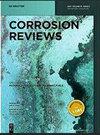氨基磺酸是一种用于工业酸洗和缓蚀的环保型替代电解质
IF 3.2
4区 材料科学
Q3 ELECTROCHEMISTRY
引用次数: 2
摘要
摘要氨基磺酸(H3NSO3),也称为氨基硫酸、氨基磺酸、氨基磺酸和氨基磺酸,是一种工业上有用的水溶性无色结晶固体。不同浓度的氨基磺酸溶液被广泛用于去除金属和陶瓷表面的水垢和金属氧化物沉积物。氨基磺酸溶液(5–10%)可作为替代电解质,用于去除铁锈和石灰皮,以取代刺激性和挥发性相对较高的盐酸和硫酸电解质。氨基磺酸溶液可以被认为是用于清洁金属表面的相对更环保、毒性更小的电解质。然而,与流行的酸性溶液类似,氨基磺酸基电解质对金属和金属结构具有腐蚀性。因此,天然和合成来源的基于有机化合物的缓蚀剂被广泛用于防止此类电解质中金属表面的腐蚀性损伤。这些化合物通过遵循Langmuir吸附等温线模型在金属表面上吸附而变得有效。通过电化学分析,观察到氨基磺酸基电解质中的有机缓蚀剂表现为混合型和界面型缓蚀剂,它们通过在金属/电解质界面上吸附而变得有效。大多数缓蚀剂的吸附大多遵循物理化学吸附机理。本文章由计算机程序翻译,如有差异,请以英文原文为准。
Sulfamic acid is an environment-friendly alternative electrolyte for industrial acid cleaning and corrosion inhibition: a mini review
Abstract Sulfamic acid (H3NSO3), which is also known as amino sulfuric acid, sulfamidic acid, amidosulfonic acid, and aminosulfonic acid, is an industrially useful water-soluble colorless crystalline solid. Sulfamic acid solutions of different concentrations are widely used for the removal of scales and metal oxides deposits from the surface of metals and ceramics. Sulfamic acid solutions (5–10%) serve as alternative electrolytes for the removal of rusts and lime scales to replace relatively more irritating and volatile hydrochloric and sulfuric acid-based electrolytes. Sulfamic acid solutions can be regarded as relatively more environmentally friendly and less toxic electrolytes for the cleaning of metallic surfaces. However, similar to the popular acidic solutions, sulfamic acid based electrolytes are corrosive to metal and metallic structures. Therefore, organic compounds based corrosion inhibitors of natural and synthetic origin are widely used to prevent corrosive damage of metallic surfaces in such electrolytes. These compounds become effective by adsorbing on the metallic surface following through the Langmuir adsorption isotherm model. Using electrochemical analyses it was observed that organic corrosion inhibitors in sulfamic acid based electrolytes behave as mixed- and interface-type corrosion inhibitors and they become effective by adsorbing at the metal/electrolyte interfaces. The adsorption of most of the corrosion inhibitors mostly follows physiochemisorption mechanism.
求助全文
通过发布文献求助,成功后即可免费获取论文全文。
去求助
来源期刊

Corrosion Reviews
工程技术-材料科学:膜
CiteScore
5.20
自引率
3.10%
发文量
44
审稿时长
4.5 months
期刊介绍:
Corrosion Reviews is an international bimonthly journal devoted to critical reviews and, to a lesser extent, outstanding original articles that are key to advancing the understanding and application of corrosion science and engineering in the service of society. Papers may be of a theoretical, experimental or practical nature, provided that they make a significant contribution to knowledge in the field.
 求助内容:
求助内容: 应助结果提醒方式:
应助结果提醒方式:


